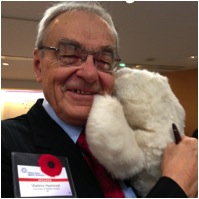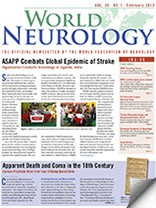By Vladimir Hachinski, MD, FRCPC, DSc

Dr. Hachinski with Paro, a Canadian harbor seal robot designed to stimulate patients with cognitive disorders.
Japan has the longest life expectancy and the oldest population in the world. Japanese men on average live to 85 years and women to 87 years. Twenty-five per cent of Japanese are over the age of 65 years. In light of this, the relevance of the focus of the meeting on new models of dementia care and prevention appears clear.
The presence of Prime Minister Shinzo Abe reflected the importance of the meeting. He promised a new dementia strategy for Japan. Yusuhisa Shiozaki, Minister of Health, Labour and Welfare for Japan participated actively, as did the members of the World Dementia Council, Kiyoshi Kurokawa from Japan and Yves Joanette from Canada. Hachinski addressed the question “Can we prevent or delay dementia?” He stated that it was possible only if we adopted new approaches. He spoke of the shortcomings of current diagnostic categories and the desirability of using standardized descriptions recommended by an international group of experts that he led. In addition he emphasized that modern technology allows the “in vivo” study of some of the main mechanisms of dementia, including imaging brain amyloid, tau protein, activated microglia (signs of inflammation) and micro and macrovascular brain disease. He stressed that vascular disease is not only important as a cause, but as a trigger of dementia, illustrated by treatable interactive mechanisms identified by his research group. He also pointed out that in prevention we tend to focus on information, which is not enough. He outlined a three-step approach for successful prevention: 1) Risk assessment, 2) Motivation and 3) Enablement.
The meeting hosted impressive exhibitions of technology, particularly advanced robots, including cuddly Paro, a therapeutic robot Canadian harbor seal that blinks its eyes and moves its tail when hugged (Please see photo).
In the discussion, Hachinski quoted Yogi Berra “When you come to a fork in the road, take it!” He gave reasons why we must take the long road to understanding and treating disease mechanisms, but also why we must take a short road to prevent and control the vascular component that is present in all major dementias, ranging from 60 percent in frontotemporal dementias to 80 percent in Alzheimer disease. The fact that dementia incidence is decreasing in Holland and Sweden, two countries where the stroke incidence has been cut in half in the past two decades, suggests that preventing and treating cerebrovascular disease holds the most realistic promise of preventing or delaying dementia.
